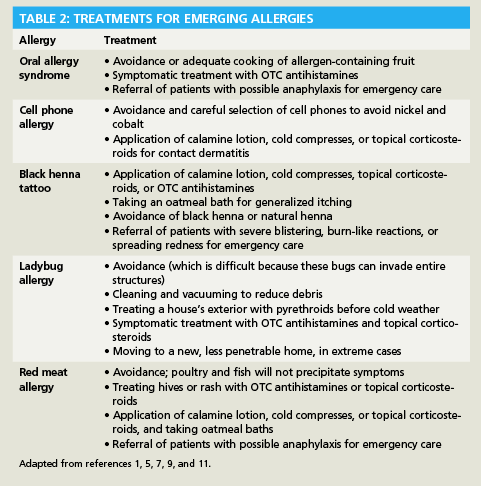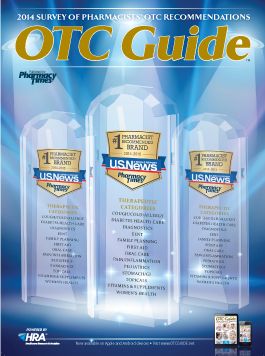Publication
Article
OTC Guide
Odd Allergies: OTC Answers?
Author(s):
Pharmacists May Encounter Patients with Newly Identified Allergies
Pharmacists May Encounter Patients with Newly Identified Allergies
It’s cute when a child who hates peas shuns them, claiming he’s allergic. And you’ve probably heard a coworker joke, “Can’t help today, I’m allergic to work.” Some peoples’ allergy claims seem so absurd, it’s hard to react without a laugh or an eye roll. The fact is, new allergies are reported all the time, some of which seem preposterous. Pharmacists may hear from patients who have newly identified, increasingly important allergies, some of which are discussed here.
A Fruity Allergy
Oral allergy syndrome (OAS; often called pollen-food allergy) affects 10% to 33% of people with allergies. Diagnosticians first recognized OAS as a unique allergy in 1942.1,2 This affliction occurs more often in summer, and almost all affected patients also have hay fever. Patients develop OAS after respiratory sensitization with pollen.
OAS’s most common cause is pathogenesis-related (PR) protein. Higher-order plants generate PR proteins in response to fungal or bacterial infections or stress (eg, drought, flooding, freezing, ultraviolet B light, ozone, mechanical injury). For plants, PR proteins are protective; for humans, they can be allergens. The largest group of PR proteins is a major birch tree allergen, and patients allergic to birch pollen often cross-react to various raw fruits. Allergists report that OAS is the most common food allergy in adults.1

Patients with OAS experience symptoms—itching, stinging pain, and vascular edema of the lips, tongue, palate, and pharynx—after eating raw fruits that contain food antigens with structural similarities to PR protein (Table 1).1-3 Pharmacists should note that heat and digestion destroy PR proteins, so patients can eat cooked, canned, and preserved fruits without developing symptoms.3
Call Me Later!
Almost all Americans use cell phones, and many use them often and indiscriminately. Gaming, e-mailing, texting, listening to music, taking pictures, watching movies, reading, and navigating the Internet are all possible on many cell phones. A number of case reports have described cell phone allergies, which generally present as contact dermatitis.4,5
Many popular cell phones contain nickel and/or cobalt, which are common allergens. Recently, a team of researchers tested 72 cell phones, including flip phones, BlackBerrys, iPhones, and Droids. All iPhones and Droids were nickel- and cobalt-free. One-fourth of BlackBerrys tested positive for nickel; none contained cobalt. Approximately 90.5% of flip phones contained nickel, and about half contained cobalt.
Patients who have metal allergies should investigate a phone’s metal content before purchasing it, and they should avoid exposure. Consumers need to know that metal sensitization can occur through exposure, and wear on phone keypads can increase the likelihood of exposure to underlying metal.4,5
A Boo-Hoo of a Tattoo
With tattoos being popular, people—especially children—who want tattoos without a lifelong commitment sometimes apply temporary tattoos painted with natural henna that contains added darkening agents. A common additive, para-phenylenediamine (PPD), creates a blackened henna and has been associated with allergic skin reactions (eg, itching, redness, blistering, mottled tone, infection, and occasionally, permanent scarring). The FDA approved PPD for use in hair dye, but not for direct skin application.6,7
Allergic reaction to PPD usually develops within 3 weeks after tattooing, but it can occur as soon as 24 hours after tattooing in sensitized individuals. A reaction to PPD in a henna product can subsequently predispose patients to allergic responses to hair dye, sunscreen, and medications with similar chemical structures.6,7
My Allergy Is Bugging Me!
House dust mites and cockroaches are well-known allergens, but in some areas of the United States, up to 25% of people are allergic to ladybugs—yes, you read that correctly! Farmers introduced Asian ladybugs (Harmonia axyridis) in the 1970s and 1980s as a pest-control predator, especially for aphids. Cold winters were expected to control the ladybug population, but they haven’t. Ladybugs’ unfettered reproduction has created infestations across the country. In autumn, ladybugs (which are inhalant allergens) enter warm homes to escape the cold and to hibernate. Symptoms of ladybug allergy—allergic rhinitis, asthma, itching, and sometimes chronic cough—are most common in autumn, but they peak in spring when ladybugs swarm; symptoms may persist all winter.8,9
Tick, Tick, Tick…
Food hypersensitivity reactions—syndromes that are increasing in prevalence—are usually mediated by IgE antibodies against food allergens (eg, eggs, seafood, milk, tree nuts, peanuts, wheat, soy). Authentic allergy to meat (an immediate reaction with IgE directed against specific proteins) is rare. Recently, the medical literature has described a new syndrome involving a delayed reaction to mammalian red meat; the reaction is associated with IgE antibodies directed against alpha-gal oligosaccharides. The alpha-gal epitope is present in beef, pork, lamb, cat dander, and sometimes milk. Tick bites from the species Amblyomma americanum (Lone Star tick) seem to precede alpha-gal hypersensitivity. Lone Star ticks are widespread in the southeast and south central areas of the United States.10,11 Children seem to be at elevated risk of red meat allergy, especially if they live in Tennessee, North Carolina, or Virginia.12
Patients with red meat allergy develop symptoms (itching and other reactions, including difficulty breathing, hives, diarrhea, and outright anaphylaxis) 4 to 6 hours after eating red meat. This delayed reaction is unlike typical allergic reactions, which occur immediately, and it muddies diagnosis; astute clinicians will identify this syndrome if they take detailed histories or have patients keep a food diary. This allergy tends to diminish with time.10,11 Of note, a similar (and unidentified) mechanism seems to be associated with cetuximab allergy.10-13 The Centers for Disease Control and Prevention has determined that alpha-gal sensitivity is more likely in states with high rates of obesity. This raises a question: are high-fat diets a risk factor?13
The Pharmacist’s Role
Patients may visit the pharmacy and report these allergies or just their symptoms. Whenever patients allege that they have allergies, pharmacists should ask about symptoms, possible exposures to allergens, and the timing of reactions. If patients report fever, chest pain, rapidly worsening symptoms, or serious comorbidities, they are best treated in the emergency department or at a specialist’s office. Table 21,5,7,9,11 describes appropriate remedies for patients who are able to self-treat.

Ms. Wick is a visiting professor at the University of Connecticut School of Pharmacy.
References
1. Webber CM, England RW. Oral allergy syndrome: a clinical, diagnostic, and therapeutic challenge. Ann Allergy Asthma Immunol. 2010;104:101-108.
2. Tuft L, Blumstein G. Studies in food allergy—sensitization to fresh fruits: clinical and experimental observations. J Allergy. 1942;13:574-578.
3. Kondo Y, Urisu A. Oral allergy syndrome. Allergol Int. 2009;58:485-491.
4. Aquino M, Mucci T, Chong M, Lorton MD, Fonacier L. Mobile phones: potential sources of nickel and cobalt exposure for metal allergic patients. Pediatr Allergy Immunol Pulmonol. 2013;26:181-186.
5. Jensen P, Menné T, Thyssen JP. Education, communication, and nickel allergy—now is the time for stricter discipline. Contact Dermatitis. 2013;68:116.
6. Minnesota State News Service. Public warned against use of additives in henna used to create “temporary tattoos”: materials added to henna can cause reactions, scarring on skin, other health problems [published June 30, 2011]. http://go.galegroup.com/ps/i.do?id=GALE%7CA260181667&v=2.1&u=arl_library&it=r&p=EAIM&sw=w&asid=d53a35b2affefd43edaff62201f77cb0. Accessed March 29, 2014.
7. de Groot AC. Side-effects of henna and semi-permanent “black henna” tattoos: a full review. Contact Dermatitis. 2013;69:1-25.
8. Goetz DW. Seasonal inhalant insect allergy: Harmonia axyridis ladybug. Curr Opin Allergy Clin Immunol. 2009;9:329-333.
9. Nakazawa T, Satinover SM, Naccara L, et al. Asian ladybugs (Harmonia axyridis): a new seasonal indoor allergen. J Allergy Clin Immunol. 2007;119:421-427.
10. Saleh H, Embry S, Nauli A, Atyia S, Krishnaswamy G. Anaphylactic reactions to oligosaccharides in red meat: a syndrome in evolution. Clin Mol Allergy. 2012;10:5.
11. Commins SP, Platts-Mills TA. Delayed anaphylaxis to red meat in patients with IgE specific for galactose alpha-1,3-galactose (alpha-gal). Curr Allergy Asthma Rep. 2013;13:72-77.
12. Boerner C. Red meat allergies likely result of Lone Star tick. Expanded Academic ASAP website. http://go.galegroup.com/ps/i.do?id=GALE%7CA359161964&v=2.1&u=arl_library&it=r&p=EAIM&sw=w&asid=6cc0e5314bbb50e7f57ed348eeb2bee3. Accessed March 29, 2014.
13. Chung CH, Mirakhur B, Chan E, et al. Cetuximab-induced anaphylaxis and IgE specific for galactose-alpha-1,3-galactose. N Engl J Med. 2008;358:1109-1117.







